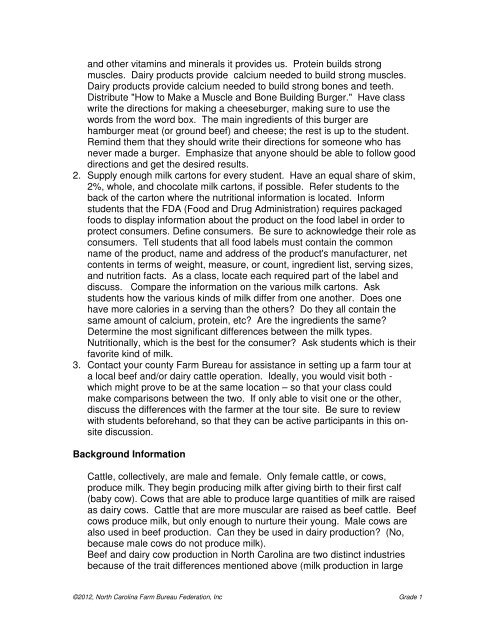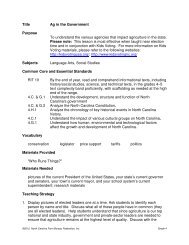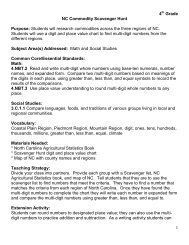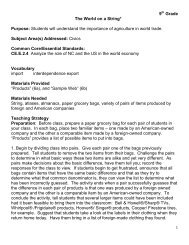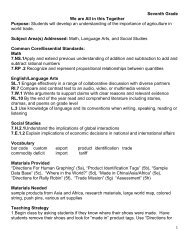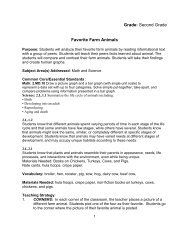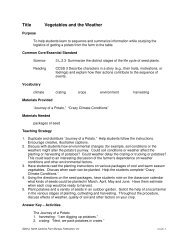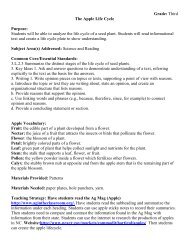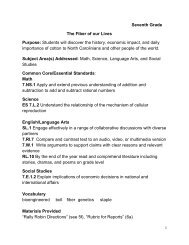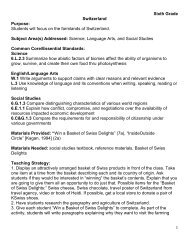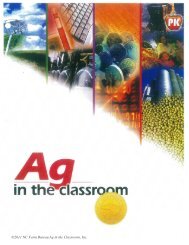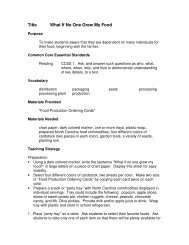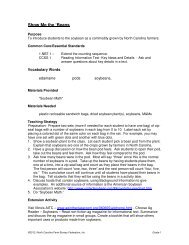Lesson Plan 9 - Cow 'Bout That! - Ag in the Classroom
Lesson Plan 9 - Cow 'Bout That! - Ag in the Classroom
Lesson Plan 9 - Cow 'Bout That! - Ag in the Classroom
You also want an ePaper? Increase the reach of your titles
YUMPU automatically turns print PDFs into web optimized ePapers that Google loves.
and o<strong>the</strong>r vitam<strong>in</strong>s and m<strong>in</strong>erals it provides us. Prote<strong>in</strong> builds strongmuscles. Dairy products provide calcium needed to build strong muscles.Dairy products provide calcium needed to build strong bones and teeth.Distribute "How to Make a Muscle and Bone Build<strong>in</strong>g Burger." Have classwrite <strong>the</strong> directions for mak<strong>in</strong>g a cheeseburger, mak<strong>in</strong>g sure to use <strong>the</strong>words from <strong>the</strong> word box. The ma<strong>in</strong> <strong>in</strong>gredients of this burger arehamburger meat (or ground beef) and cheese; <strong>the</strong> rest is up to <strong>the</strong> student.Rem<strong>in</strong>d <strong>the</strong>m that <strong>the</strong>y should write <strong>the</strong>ir directions for someone who hasnever made a burger. Emphasize that anyone should be able to follow gooddirections and get <strong>the</strong> desired results.2. Supply enough milk cartons for every student. Have an equal share of skim,2%, whole, and chocolate milk cartons, if possible. Refer students to <strong>the</strong>back of <strong>the</strong> carton where <strong>the</strong> nutritional <strong>in</strong>formation is located. Informstudents that <strong>the</strong> FDA (Food and Drug Adm<strong>in</strong>istration) requires packagedfoods to display <strong>in</strong>formation about <strong>the</strong> product on <strong>the</strong> food label <strong>in</strong> order toprotect consumers. Def<strong>in</strong>e consumers. Be sure to acknowledge <strong>the</strong>ir role asconsumers. Tell students that all food labels must conta<strong>in</strong> <strong>the</strong> commonname of <strong>the</strong> product, name and address of <strong>the</strong> product's manufacturer, netcontents <strong>in</strong> terms of weight, measure, or count, <strong>in</strong>gredient list, serv<strong>in</strong>g sizes,and nutrition facts. As a class, locate each required part of <strong>the</strong> label anddiscuss. Compare <strong>the</strong> <strong>in</strong>formation on <strong>the</strong> various milk cartons. Askstudents how <strong>the</strong> various k<strong>in</strong>ds of milk differ from one ano<strong>the</strong>r. Does onehave more calories <strong>in</strong> a serv<strong>in</strong>g than <strong>the</strong> o<strong>the</strong>rs? Do <strong>the</strong>y all conta<strong>in</strong> <strong>the</strong>same amount of calcium, prote<strong>in</strong>, etc? Are <strong>the</strong> <strong>in</strong>gredients <strong>the</strong> same?Determ<strong>in</strong>e <strong>the</strong> most significant differences between <strong>the</strong> milk types.Nutritionally, which is <strong>the</strong> best for <strong>the</strong> consumer? Ask students which is <strong>the</strong>irfavorite k<strong>in</strong>d of milk.3. Contact your county Farm Bureau for assistance <strong>in</strong> sett<strong>in</strong>g up a farm tour ata local beef and/or dairy cattle operation. Ideally, you would visit both -which might prove to be at <strong>the</strong> same location – so that your class couldmake comparisons between <strong>the</strong> two. If only able to visit one or <strong>the</strong> o<strong>the</strong>r,discuss <strong>the</strong> differences with <strong>the</strong> farmer at <strong>the</strong> tour site. Be sure to reviewwith students beforehand, so that <strong>the</strong>y can be active participants <strong>in</strong> this onsitediscussion.Background InformationCattle, collectively, are male and female. Only female cattle, or cows,produce milk. They beg<strong>in</strong> produc<strong>in</strong>g milk after giv<strong>in</strong>g birth to <strong>the</strong>ir first calf(baby cow). <strong>Cow</strong>s that are able to produce large quantities of milk are raisedas dairy cows. Cattle that are more muscular are raised as beef cattle. Beefcows produce milk, but only enough to nurture <strong>the</strong>ir young. Male cows arealso used <strong>in</strong> beef production. Can <strong>the</strong>y be used <strong>in</strong> dairy production? (No,because male cows do not produce milk).Beef and dairy cow production <strong>in</strong> North Carol<strong>in</strong>a are two dist<strong>in</strong>ct <strong>in</strong>dustriesbecause of <strong>the</strong> trait differences mentioned above (milk production <strong>in</strong> large©2012, North Carol<strong>in</strong>a Farm Bureau Federation, Inc Grade 1


